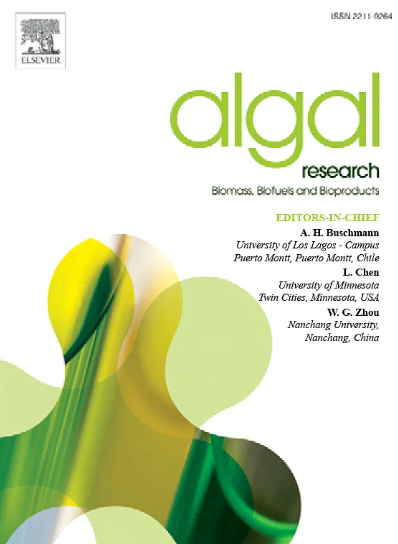Influence of season, inoculum density and ammonia concentration on biomass abundance and ammonia utilization of a microalgal consortium for tertiary remediation of tannery wastewater and valorization of biomass
IF 4.6
2区 生物学
Q1 BIOTECHNOLOGY & APPLIED MICROBIOLOGY
Algal Research-Biomass Biofuels and Bioproducts
Pub Date : 2025-06-09
DOI:10.1016/j.algal.2025.104137
引用次数: 0
Abstract
Phyco-remediation has been advocated as a tertiary step for simultaneous remediation of tannery wastewater and valorization of microalgal biomass. This study was based on the hypothesis that climatic factors could be important functional determinants for system performance in open phyco-remediation systems subject to seasonal variations. In this study, ammonia utilization and biomass abundance obtained by a microalgal consortium (Tetradesmus obliquus CCAP 276/1A, Tetradesmus obliquus CPUT-L1, Tetradesmus dimorphus CPUT-L2, Neochloris sp. CPUT-W1) in treated tannery wastewater were measured under simulated winter, autumn/spring and summer conditions (temperature: 8.0 °C, 17.5 °C, 27.0 °C, respectively; photoperiod: 10:14 h, 12:12 h, 14:10 h light:dark, respectively) with varied initial ammonia (7.4 mg/L to 45.6 mg/L) and inoculum size (6 % vol./vol to 34 % vol./vol.) in 500 mL flasks (350 mL working volume) in shaking incubators at 160 rpm. Season had highly significant effects (p < 0.0001) on both responses in an increasing continuum from winter to summer (biomass: 0.39 ± 0.06 g/L to 0.72 ± 0.07 g/L; ammonia utilization 1.7 ± 0.6 mg/day to 4.1 ± 1/6 mg/day). The inoculum size did not have significant effects on either response (p > 0.5), while the initial ammonia concentration had a highly significant effect (p < 0.0001) on the ammonia utilization rate, but not on biomass abundance. Despite the halo-tolerant nature of the microalgal strains, sodium removal efficiency was <1 %, indicating that it is unlikely that phyco-remediation is feasible for removal of sodium in highly saline wastewaters. Overall, this study demonstrated the importance of studying microalgal growth and remediation under climatic conditions likely to be expected in the field with a view to pilot scale implementation.

季节、接种量和氨浓度对鞣革废水三级修复微藻群落生物量丰度和氨利用的影响
植物修复已被提倡作为同时修复制革废水和微藻生物量的第三步。本研究基于气候因素可能是受季节变化影响的开放式植物修复系统性能的重要功能决定因素的假设。本研究在冬季、秋季/春季和夏季(温度分别为8.0°C、17.5°C和27.0°C)模拟条件下,测量了微藻群落(Tetradesmus obliquus CCAP 276/1A、Tetradesmus obliquus CPUT-L1、Tetradesmus dimorphus CPUT-L2、Neochloris sp. CPUT-W1)对制革废水的氨利用率和生物量丰度;光周期:10:14 h, 12:12 h, 14:10 h,分别为光和暗),不同的初始氨(7.4 mg/L至45.6 mg/L)和接种量(6% vol./vol至34% vol./vol)在500 mL烧瓶(350 mL工作体积)中,在160 rpm的振动培养箱中进行。季节影响非常显著(p <;0.0001),在从冬到夏的增加连续体中(生物量:0.39±0.06 g/L至0.72±0.07 g/L;氨利用率(1.7±0.6 mg/d ~ 4.1±1/ 6mg /d)。接种量对两种反应均无显著影响(p >;0.5),而初始氨浓度有极显著的影响(p <;0.0001)对氨利用率有显著影响,但对生物量丰度无显著影响。尽管微藻菌株具有耐光晕的特性,但其除钠效率仅为1%,这表明在高盐废水中,植物修复不太可能去除钠。总的来说,这项研究证明了在气候条件下研究微藻生长和修复的重要性,以期在现场进行中试规模实施。
本文章由计算机程序翻译,如有差异,请以英文原文为准。
求助全文
约1分钟内获得全文
求助全文
来源期刊

Algal Research-Biomass Biofuels and Bioproducts
BIOTECHNOLOGY & APPLIED MICROBIOLOGY-
CiteScore
9.40
自引率
7.80%
发文量
332
期刊介绍:
Algal Research is an international phycology journal covering all areas of emerging technologies in algae biology, biomass production, cultivation, harvesting, extraction, bioproducts, biorefinery, engineering, and econometrics. Algae is defined to include cyanobacteria, microalgae, and protists and symbionts of interest in biotechnology. The journal publishes original research and reviews for the following scope: algal biology, including but not exclusive to: phylogeny, biodiversity, molecular traits, metabolic regulation, and genetic engineering, algal cultivation, e.g. phototrophic systems, heterotrophic systems, and mixotrophic systems, algal harvesting and extraction systems, biotechnology to convert algal biomass and components into biofuels and bioproducts, e.g., nutraceuticals, pharmaceuticals, animal feed, plastics, etc. algal products and their economic assessment
 求助内容:
求助内容: 应助结果提醒方式:
应助结果提醒方式:


